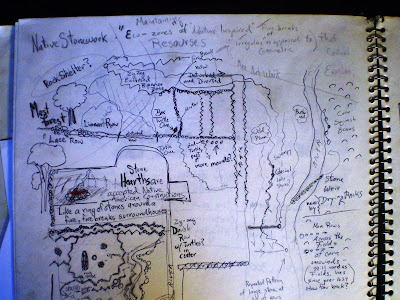
Manitou
From Wikipedia, the free encyclopedia:
"Manitou is a term used to designate the spirits among many Algonquian groups. It refers to the concept of one aspect of the interconnection and balance of nature/life, similar to the East Asian concept of qi (In traditional Chinese culture, qi (氣 / 气; Pinyin qì, Wade-Giles ch'i Jyutping hei; Korean gi; Japanese ki; Vietnamese khí; pronounced IPA: [tɕʰi˥˩] in Standard Mandarin) is an active principle forming part of any living thing.
It is frequently translated as "energy flow," and is often compared to Western notions of energeia or élan vital (vitalism) as well as the yogic notion of prana. The literal translation is "air," "breath," or "gas" (compare the original meaning of Latin spiritus "breathing"; or the Common Greek πνεῦμα, meaning "air," "breath," or "spirit"; and the Sanskrit term prana, "breath" ); in simpler terms it can refer to a spirit. This spirit is seen as a (contactable) person as well as a concept. Everything has its own manitou—every plant, every stone, even machines. In the shamanistic traditions the manitous (or manidoog or manidoowag) are connected to achieve a desired effect, like plant manitous for healing or the buffalo manitou for a good hunt. In the Anishinaabeg tradition manidoowag are one aspect of the Great Connection. Related terms used by the Anishinaabeg are manidoowish for small animal manidoowag and manidoons for insects; both terms mean "little spirit." In other Algonquian languages such as Iynu the word manituw originally referred to underwater creatures to whom hunters offered tobacco in order to appease them when traveling through their territories.
The name of the Canadian province of Manitoba, named for Lake Manitoba in the province, derives from the place name manitou-wapow, "strait of the Manitou" in Cree or Ojibwe, referring to The Narrows at the centre of the lake.[1] Also Manitoulin Island means "spirit island."
From Wikipedia, the free encyclopedia:
"Manitou is a term used to designate the spirits among many Algonquian groups. It refers to the concept of one aspect of the interconnection and balance of nature/life, similar to the East Asian concept of qi (In traditional Chinese culture, qi (氣 / 气; Pinyin qì, Wade-Giles ch'i Jyutping hei; Korean gi; Japanese ki; Vietnamese khí; pronounced IPA: [tɕʰi˥˩] in Standard Mandarin) is an active principle forming part of any living thing.
It is frequently translated as "energy flow," and is often compared to Western notions of energeia or élan vital (vitalism) as well as the yogic notion of prana. The literal translation is "air," "breath," or "gas" (compare the original meaning of Latin spiritus "breathing"; or the Common Greek πνεῦμα, meaning "air," "breath," or "spirit"; and the Sanskrit term prana, "breath" ); in simpler terms it can refer to a spirit. This spirit is seen as a (contactable) person as well as a concept. Everything has its own manitou—every plant, every stone, even machines. In the shamanistic traditions the manitous (or manidoog or manidoowag) are connected to achieve a desired effect, like plant manitous for healing or the buffalo manitou for a good hunt. In the Anishinaabeg tradition manidoowag are one aspect of the Great Connection. Related terms used by the Anishinaabeg are manidoowish for small animal manidoowag and manidoons for insects; both terms mean "little spirit." In other Algonquian languages such as Iynu the word manituw originally referred to underwater creatures to whom hunters offered tobacco in order to appease them when traveling through their territories.
The name of the Canadian province of Manitoba, named for Lake Manitoba in the province, derives from the place name manitou-wapow, "strait of the Manitou" in Cree or Ojibwe, referring to The Narrows at the centre of the lake.[1] Also Manitoulin Island means "spirit island."
See also
Gitche Manitou
Gitche Manitou
Image source: http://www.ottertooth.com/Temagami/Sites/kokomis.htm - "a small rock squatting on the shore of Kokomis Island (aka Granny Island), now private land, in the center of this stretch. Early in this century, members of the local First Nation left food, flowers or tobacco at its base whenever they passed, and never lingered long or dared to camp on the island..."


























































